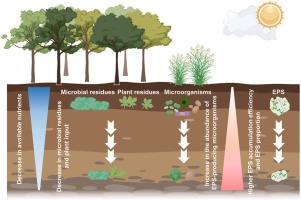微生物胞外聚合物质的增加是深层土壤有机碳积累的关键因素
IF 10.3
1区 农林科学
Q1 SOIL SCIENCE
引用次数: 0
摘要
微生物源碳通过土壤微生物碳泵形成稳定的碳组分,在减缓气候变化中起着至关重要的作用。然而,相关研究忽略了胞外聚合物(EPS)作为微生物胞外代谢物对土壤有机碳(SOC)的贡献,特别是在深层土壤中。研究了2种母质(石灰岩和页岩)和3种土地利用类型(旱地、林地和水田)6种典型土壤剖面(0 ~ 120 cm)中EPS的分布。表层土壤(0 ~ 40 cm)微生物生物量碳(MBC)对土壤有机碳的贡献显著高于eps -碳(EPS-C),而深层土壤(80 ~ 120 cm)中EPS-C所占比例更大。EPS积累效率(EPS蛋白/MBC和EPS多糖/MBC)随土壤深度的增加而逐渐增加。这种积累与g_Zixibacteria、g_Zavarzinella、g_Xylohypha、g_Xanthothecium和g_Xanthagaricus的丰度密切相关。数据分析表明,β-葡萄糖苷酶(BG)活性和总氮(TN)含量对EPS/SOC有显著的负向影响。此外,胞外酶分析证实,深层土壤低氮有效性提高了EPS积累效率,从而提高了土壤剖面上EPS- c /SOC比。总体而言,本研究提供了对深层土壤碳库组成的新认识,并突出了EPS在深层土壤碳储量中的重要作用。本文章由计算机程序翻译,如有差异,请以英文原文为准。

Increased microbial extracellular polymeric substances as a key factor in deep soil organic carbon accumulation
Microbial-derived carbon plays a crucial role in mitigating climate change by forming stable carbon components through the soil microbial carbon pump. However, related studies have ignored the contribution of extracellular polymeric substances (EPS) as microbial extracellular metabolites to soil organic carbon (SOC), particularly in deeper soils. This study explored the distribution of EPS in six typical soil profiles (0–120 cm) from two parent materials (limestone and shale) and three land use types (dryland, woodland, and paddy land). The contribution of microbial biomass carbon (MBC) to SOC was significantly higher than that of EPS-carbon (EPS-C) in surface soils (0–40 cm), while EPS-C constituted a larger proportion in deeper soils (80–120 cm). The EPS accumulation efficiency (EPS-protein/MBC and EPS-polysaccharide/MBC) gradually increased with soil depth. This accumulation was strongly correlated with the abundance of g_Zixibacteria, g_Zavarzinella, g_Xylohypha, g_Xanthothecium, and g_Xanthagaricus. Data analysis revealed that β-glucosidase (BG) activity and total nitrogen (TN) content had significant negative effects on the EPS/SOC ratio. Additionally, extracellular enzyme analyses confirmed that low nitrogen availability in deeper soils enhanced the EPS accumulation efficiency, thereby increasing the EPS-C/SOC ratio along the soil profile. Overall, this study provides new insights into the composition of deep soil carbon pools and highlights the important role of EPS in deep soil carbon storage.
求助全文
通过发布文献求助,成功后即可免费获取论文全文。
去求助
来源期刊

Soil Biology & Biochemistry
农林科学-土壤科学
CiteScore
16.90
自引率
9.30%
发文量
312
审稿时长
49 days
期刊介绍:
Soil Biology & Biochemistry publishes original research articles of international significance focusing on biological processes in soil and their applications to soil and environmental quality. Major topics include the ecology and biochemical processes of soil organisms, their effects on the environment, and interactions with plants. The journal also welcomes state-of-the-art reviews and discussions on contemporary research in soil biology and biochemistry.
 求助内容:
求助内容: 应助结果提醒方式:
应助结果提醒方式:


